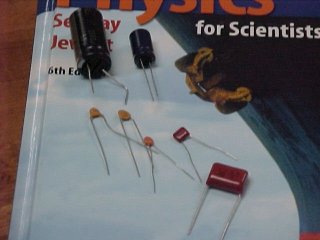How to turn your physics book into a capacitor!
A page by Devin Boyer
The Theory -
The Finished Product -
The Tools, The Plan -
Parallel Circuits -
Series Circuits -
Bibliography
The Theory
The first capacitors were very crude objects. In 1745, the Leyden jar was first described by Pieter Van Musschenbroek, a professor of physics and mathematics at the University of Leyden. He found that by wrapping both the inside and the outside of a glass container with a conductor (metal foil like gold leaf), and then a charge could accumulate from the two metal coatings (Jenkins).
Today, capacitors are made with many different materials and in many different shapes, but the basic principle is the same. If you put two conductive materials in close proximity, separated by an insulator, you create capacitance.

Several different capacitors, with a wide range of materials and capacitances
A very simple capacitor to create is the parallel plate capacitor. In the spirit of the Leyden jar (most early ones were made using household objects like bottles), I will attempt to create a capacitor using some basic easy to get material, namely my physics book and some aluminum foil.
Based on some known values, it is possible to estimate the final capacitance of my book.
Capacitance of parallel plate capacitors can be defined simply by the formula C = eA/d, where capacitance is proportional to plate area and inversely proportional to distance between plates. It is hard to give an accurate number for the area of the plates, because there is a significant variance between sheets. I would estimate this value at 35 square inches. The distance between plates can be found at a page titled Thickness of a Piece of Paper. It estimates that most paper is near .004 inches thick. This leaves two unknowns, the total capacitance and the permittivity of the paper. Using a Capacitance Calculator, it is possible to estimate the capacitance using other known values. For this calculator, I need to dielectric constant and depth, the area of one capacitor plate, and the number of plates. According to page 812 in the text book, the dielectric constant of paper is 3.7. Using these values, along with 60 plates total, I get a total of .427 uF.
Using this value of capacitance, it is possible to go back to the equation C = eA/d, and solve for e, which is 48.8 x 10^-12.
